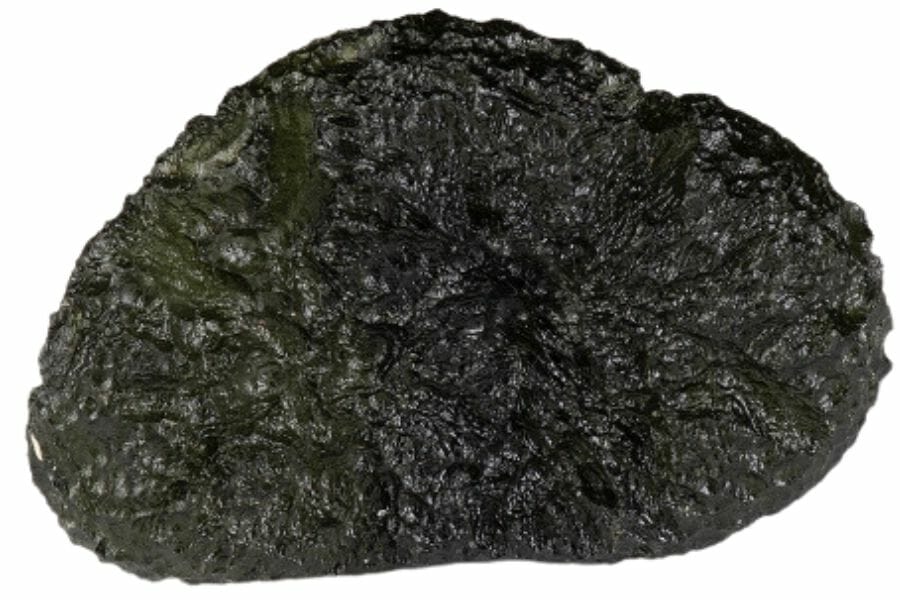Moldavite is a rare and highly sought-after type of meteorite that is believed to possess energetic and spiritual properties. As a result, the market for moldavite has grown significantly in recent years, with collectors, practitioners, and enthusiasts clamoring to get their hands on this unique gemstone.
However, with the rise in demand for moldavite, there has also been a rise in the number of fakes on the market. In this article, we’ll explore the key differences between real and fake moldavite and provide tips for identifying genuine moldavite.
We have a number of gem and mineral pricing guides and to help our readers better understand what they have we’re putting together a series of articles on how to identify fake specemins.
Understanding Moldavite’s Origins and Properties
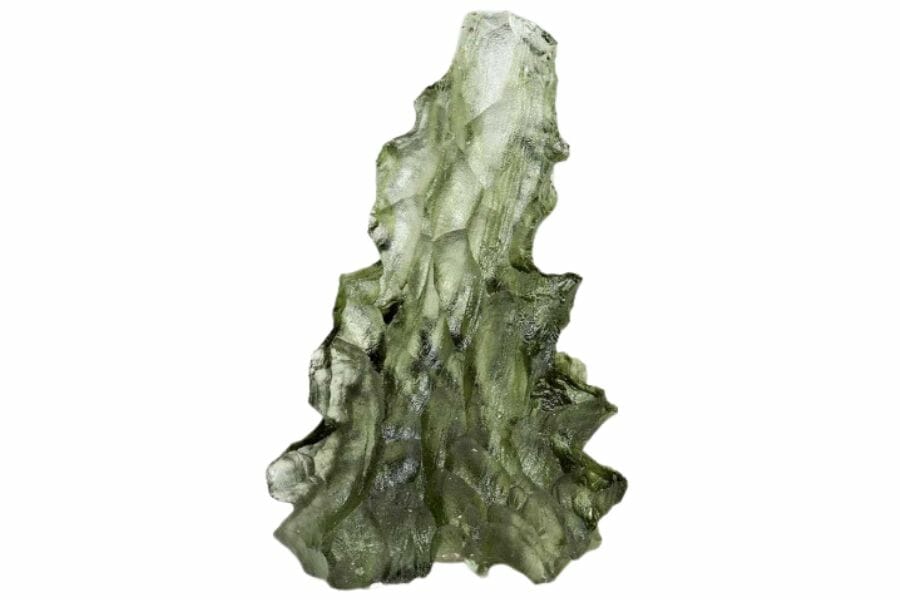
To better understand the differences between real and fake moldavite it is useful to understand where it comes from and how it’s formed:
Moldavite in brief
Moldavite is a type of green gemstone that is formed when a meteorite strikes the Earth’s surface. It is thought to be around 15 million years old, and its unique properties have made it a highly prized gemstone among collectors and practitioners.
Moldavite is typically found in the Czech Republic’s Bohemian region, but it can also be found in other areas of the world, including the United States and Germany.
Legend has it that moldavite was formed when a great fireball fell from the sky and struck the Earth. This cosmic event created a powerful energy that is still felt today.
Moldavite is said to be a stone of transformation, capable of helping individuals to break free from old patterns and habits and to embrace new beginnings.
The Formation and What Moldavite Looks LIke
Moldavite is formed when a meteorite impacts the Earth’s surface. When the meteorite hits the ground, it creates intense heat and pressure, causing the surrounding soil and rock to melt and vaporize.
The vaporized material is then ejected into the atmosphere, where it cools and solidifies, forming moldavite.
Moldavite is known for its green color, and it is believed to have a glassy texture. It is also thought to contain unique inclusions and bubbles that differentiate it from other gemstones. Genuine moldavite is lightweight, and it is usually sold in its raw, unpolished state.
One of the most interesting things about moldavite is that it is not a mineral, but rather a type of tektite. Tektites are natural glass objects that are formed when a meteorite strikes the Earth. They are found in various parts of the world and are highly valued by gem hunters and scientists alike.
The Spiritual Significance of Moldavite
Genuine moldavite is believed to possess powerful energetic and spiritual properties. It is associated with the heart chakra and is thought to help with spiritual growth and transformation.
Some practitioners also believe that moldavite can aid in astral travel and lucid dreaming and help to facilitate communication with higher realms.
Many people who work with moldavite report feeling a strong sense of connection to the Earth and to the cosmos. They describe the stone as having a high vibration that can help to awaken dormant spiritual energies within the body.
In addition to its spiritual properties, moldavite is also said to have physical healing properties. It is believed to be beneficial for the immune system, the respiratory system, and the nervous system.
Some people also use moldavite to alleviate headaches and other types of pain.
Overall, moldavite is a fascinating gemstone that has captured the attention of people around the world. Whether you are a collector, a practitioner, or simply someone who is interested in the mysteries of the universe, moldavite is a stone that is worth exploring.
The Growing Market for Moldavite and the Rise of Fakes
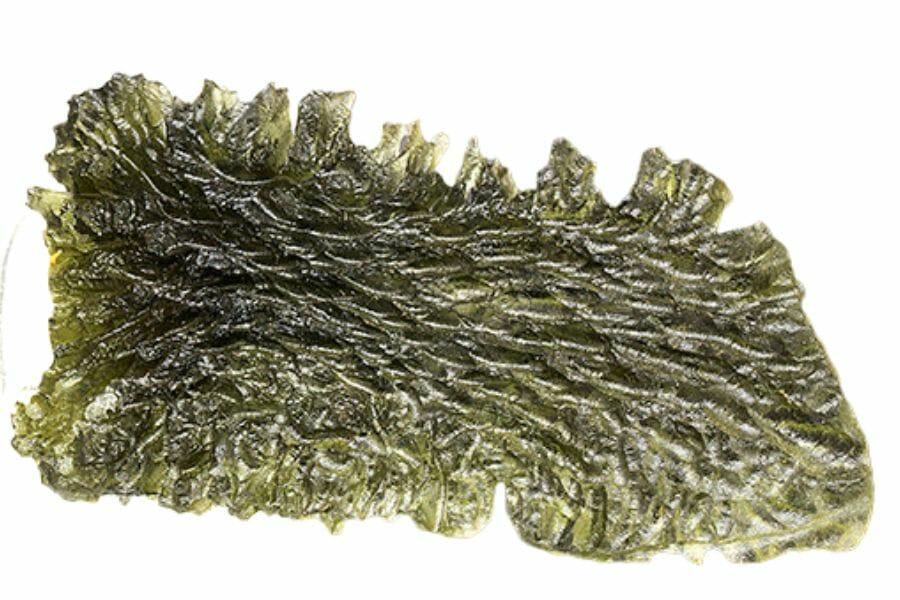
Now that we know where it comes from let’s delve into why you are seeing more and more fakes popping up:
Why Moldavite is Highly Sought After
Moldavite has captured the attention of collectors, practitioners, and enthusiasts alike. Its scarcity and unique properties have made it a highly coveted item, and it is often used in spiritual and energetic practices.
It is said to have a high vibrational frequency that can help to open and activate the chakras, enhance meditation, and facilitate spiritual growth.
Many people who work with moldavite report feeling a strong connection to the stone and experiencing intense physical and emotional sensations when holding or wearing it. Some even claim that moldavite has helped them to connect with extraterrestrial beings and access higher dimensions of consciousness.
How Fake Moldavite Entered the Market
As demand for moldavite has grown, so too has the number of fakes on the market. Many unscrupulous sellers are taking advantage of the high demand for genuine moldavite by selling cheap imitations that are made from glass or other materials.
These fakes are often difficult to spot, and many collectors and practitioners have fallen victim to these scams.
Some sellers go to great lengths to make their fake moldavite look authentic, using techniques such as acid etching or artificial aging to mimic the natural surface features of genuine moldavite.
Others may simply sell green-tinted glass or other stones that bear a superficial resemblance to moldavite.
The Impact of Fake Moldavite on Collectors and Practitioners
The rise of fake moldavite has had a significant impact on the market for genuine moldavite. Collectors and practitioners are becoming increasingly wary of purchasing moldavite, and the market is becoming flooded with cheap imitations.
This has made it difficult for genuine sellers to compete, and it has also resulted in many people losing faith in the authenticity of moldavite.
However, there are steps that collectors and practitioners can take to protect themselves from purchasing fake moldavite. One of the most important things is to educate oneself about the characteristics of genuine moldavite, such as its unique surface features and natural green color.
It is also important to purchase moldavite from reputable sellers who can provide documentation and guarantees of authenticity.
Despite the challenges posed by fake moldavite, the market for genuine moldavite continues to grow. As more people become aware of its unique properties and seek to incorporate it into their spiritual practices, the demand for genuine moldavite is likely to remain strong.
With vigilance and knowledge, collectors and practitioners can continue to enjoy the benefits of this rare and powerful gemstone.
The Key Differences Between Real and Fake Moldavite
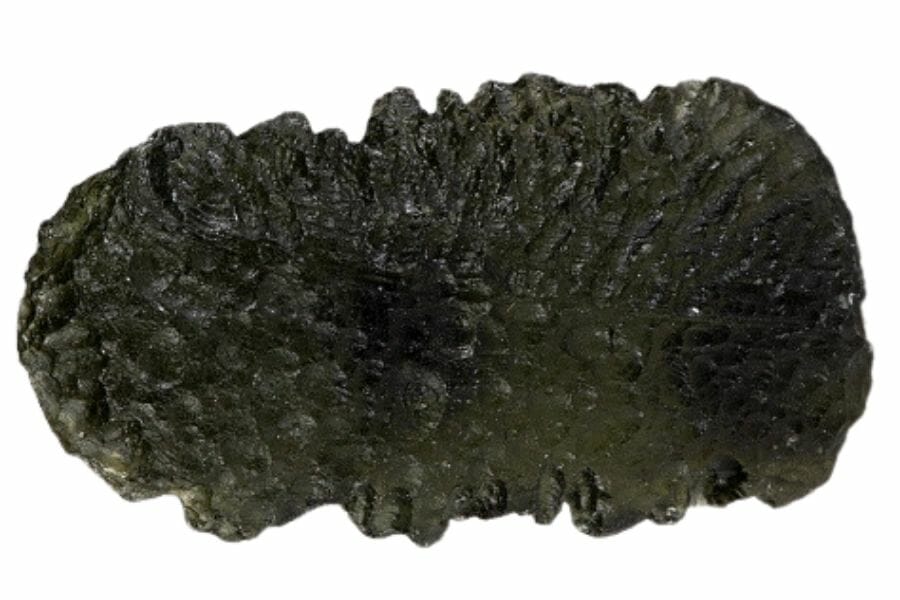
These are the most common ways that even inexperienced collectors can identify a fake moldavite:
Visual Differences: Color, Texture, and Shape
One of the key differences between real and fake moldavite is its color. Genuine moldavite is typically a deep green color, while fake moldavite can vary in shades of green and brown.
The texture of real moldavite is also unique, and it is often described as having a bubbly or pitted surface. Fake moldavite is often smoother in texture.
The shape of moldavite can also be an indicator of its authenticity. Genuine moldavite typically has an irregular shape, with rough edges and an uneven surface. Fake moldavite is often cut into regular shapes, such as ovals or circles, which is a tell-tale sign of its inauthenticity.
Physical Properties: Density, Hardness, and Inclusions
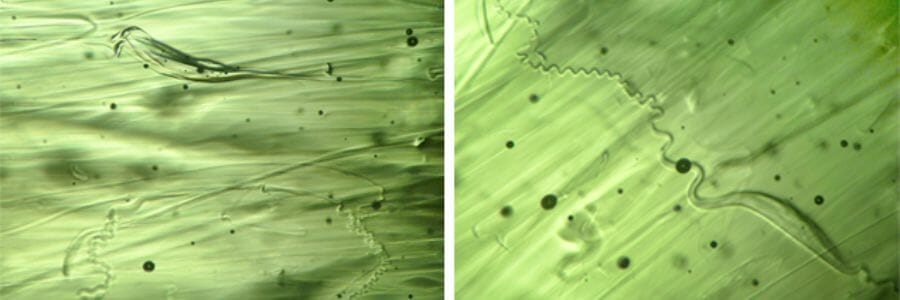
Another key difference between real and fake moldavite is its physical properties. Genuine moldavite is lightweight and has a density of around 2.3 – 2.5 g/cm³. It is also relatively soft, with a hardness of around 5 – 5.5 on the Mohs scale.
Fake moldavite is often heavier than genuine moldavite and has a higher density. It is also harder than genuine moldavite, with a hardness of around 7 on the Mohs scale.
Genuine moldavite also contains unique inclusions and bubbles as you can see in the image above, which are a result of its formation process. These inclusions can be seen under a microscope, and they are unique to genuine moldavite.
Fake moldavite often lacks these inclusions, which is another indicator of its inauthenticity.
Energetic Differences: Vibrations and Energy Signatures
This isn’t going to be a method that everyone will appreciate but for those that believe in the energy properties of Moldavite, it is believed to possess powerful energetic and spiritual properties.
For this reason, many practitioners and collectors rely on the energetic vibrations and energy signatures of moldavite to determine its authenticity.
Genuine moldavite is said to have a unique vibration that is powerful and intense. It is also believed to have an energy signature that is distinct from other gemstones.
Fake moldavite, on the other hand, often lacks these energetic qualities, making it easy to distinguish from genuine moldavite.
How You Can Identify Genuine Moldavite
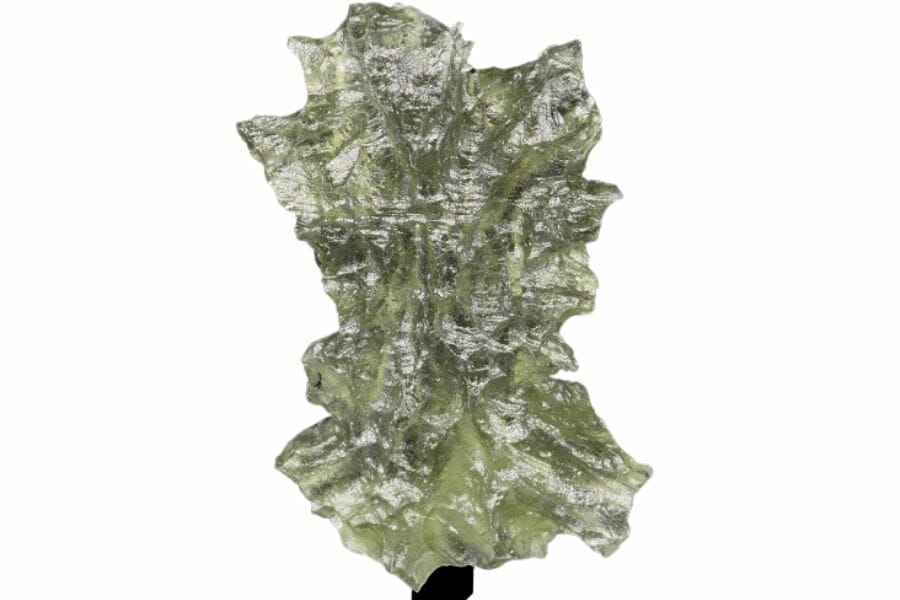
Even if you don’t have a lot of experience in the area there are a handful of things you can do to ensure you are buying genuine specimens:
Buy from Reputable Sources
One of the best ways to ensure that you are purchasing genuine moldavite is to buy from reputable sources. Look for sellers who specialize in moldavite and who have a reputation for selling high-quality, authentic gemstones and are members of professional organizations like The American Gem Society and the International Gem Society.
Avoid buying from online marketplaces or auction sites where there is a higher likelihood of encountering fakes.
Examining Moldavite with a Loupe or Magnifying Glass
Another tip for identifying genuine moldavite is to examine it up close with a loupe or magnifying glass. Look for unique inclusions and bubbles that are characteristic of genuine moldavite.
Genuine moldavite is also known for its pitted surface and irregular shape, which can be seen more clearly under magnification.
Performing an Energy Test
If you are unsure about the authenticity of your moldavite, you can perform an energy test to determine its energetic properties. Hold the moldavite in your hand and focus on its vibration and energy signature.
Genuine moldavite is said to have a powerful and intense vibration, and it is believed to have an energy signature that is distinct from other gemstones. By performing an energy test, you can determine whether your moldavite is genuine or fake.
By following these tips and familiarizing yourself with the key differences between real and fake moldavite, you can ensure that you are purchasing genuine moldavite and avoid falling victim to scams.
Remember to always buy from reputable sources and to examine the moldavite up close to determine its authenticity. By doing so, you can enjoy the spiritual and energetic properties of genuine moldavite and experience its transformative power.

